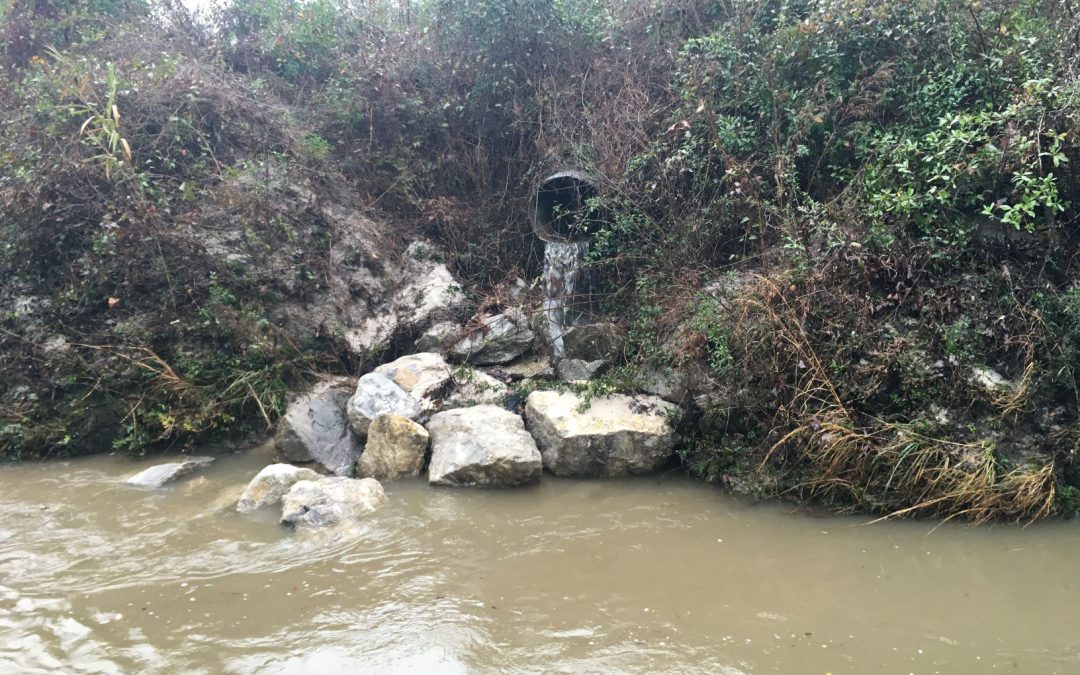
by Matt Deitch | May 8, 2020
Urbanization—the process of conversion from forests, grasslands, or agricultural fields to predominantly residential, commercial, and industrial settings—can cause profound changes to the pathways that rainfall takes to become streamflow. This landscape conversion leads to less water infiltrating into soil and more water running directly into streams and other nearby water bodies (such as lakes, wetlands, and bayous). Urban water runoff carries pollutants that have accumulated on the landscape and in soil since the previous rainfall. If the concentrations of pollutants in streams are large enough, they can cause problems for the organisms that live in streams as well as those in the bays and bayous those streams flow into (often called receiving waters).

Stormwater conveyance in Santa Rosa nd Escambia counties.
Photo: Matt Deitch
Local governments play a key role in mitigating the impacts of urbanization on aquatic ecosystems. In northwest Florida, County government is often responsible for limiting pollutant inputs from the network of surface and underground stormwater conveyances known as “municipal separate storm sewer systems” (abbreviated as MS4s). The United States EPA requires urban areas to be regulated as sources of pollutant discharge through their National Pollutant Discharge Elimination System (abbreviated NPDES); departments within Escambia County and Santa Rosa County government coordinate the administration of these permits with the US EPA.
The requirements of these MS4 water quality permits vary depending on the population of the area. Permits for medium and large cities or counties having populations greater than 100,000 are categorized as “Phase I” MS4s, while areas with smaller populations are categorized as being “Phase II” MS4s. These two categories have many similar requirements, but also have a few important differences. Permits for both types of MS4s require local agencies to develop methods for community outreach on stormwater pollution issues, controlling runoff from construction sites, and requiring stormwater management in new developments. In addition to the requirements listed above, Phase I MS4s require the implementation of a water quality monitoring program and a plan to reduce pollutants from developed areas.
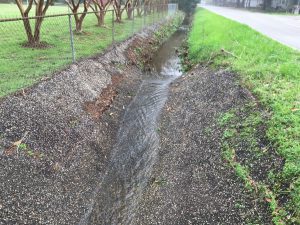
Stormwater conveyance in Santa Rosa and Escambia counties.
Photo: Matt Deitch
In Spring 2020, the southern portion of Santa Rosa County transitioned from a Phase II MS4 region to Phase I. This means that Santa Rosa County will begin implementation of a surface water monitoring program to evaluate pollutant concentrations in stormwater conveyances (including creeks); and develop plans for reducing pollutants from their MS4s entering the Pensacola Bay System. This program will make important contributions to understanding the effects of urban development on our local streams and estuaries, and improve water quality in the Pensacola Bay System.
This is a great opportunity to remind us of the importance of disposing our personal protective equipment including face masks, plastic gloves, and other single-use items we use to protect ourselves from the coronavirus in the trash after use. Leaving it on the curb or in parking lots means that it can wash into stormwater ponds or creeks and bayous, which can cause problems for the animals that live there.
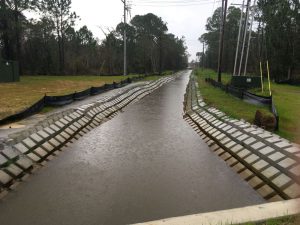
Stormwater conveyance in Escambia and Santa Rosa counties.
Photo: Matt Deitch

by Matt Deitch | Mar 13, 2020
Flooding and poor water quality are common issues of concern in the Florida Panhandle. Our frequent heavy rains cause water to quickly run off rooftop, parking lot, and driveway surfaces; this runoff water carries with it the chemicals deposited on land surfaces between rain events by direct application (such as landscape fertilizers) as well as through wind and circulation, a process referred to as atmospheric deposition. Surface water that runs off our developed urban and residential landscape is usually routed into stormwater drains and sewers, and then into stormwater detention ponds or directly into surface streams.
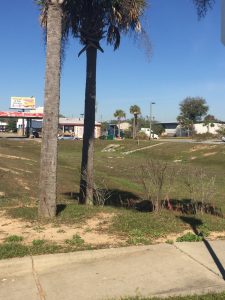
Dry stormwater pond in Escambia County.
Photo: Matt Deitch
Conventional methods for dealing with stormwater runoff is through the use of stormwater ponds. Stormwater ponds allow water to slowly infiltrate into the soil before moving to streams or wetlands via shallow groundwater pathways. Typically hidden behind shopping centers or in the back of residential subdivisions, stormwater ponds attenuate flooding by delaying the time when water reaches the stream and are intended to improve water quality through microbial processes (such as denitrification) or plant uptake, particularly focusing on reducing the amount of nitrogen and phosphorus that reaches nearby streams. However, the efficacy of stormwater ponds is highly variable (many do not function as intended), and they often are visually unattractive aspects of a community.
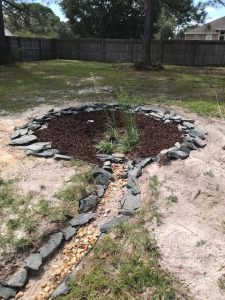
A backyrad rain garden after installation near Navarre FL.
Photo: Nikki Bennett
Stormwater managers in other parts of Florida are increasingly utilizing a suite of management features termed “green infrastructure” as alternatives to stormwater ponds to reduce floodwaters and improve water quality before it enters nearby streams and wetlands. Green infrastructure, which includes features such as rain gardens, green rooftops, rainwater cisterns, bioswales, and permeable pavers, is designed to slow water down and reduce pollutant concentrations by mimicking natural processes of infiltration and biological uptake at its source—off the rooftops, driveways, roads, and parking lots where stormwater first concentrates. As a result, green infrastructure reduces surface runoff that occurs during storm events, leading to less flooding downstream. With the magnitude of peak flow reduced, stormwater runoff is also likely to carry lower amounts of pollutants downstream. In addition to their capacity to reduce flooding and improve water quality, green infrastructure can have many other benefits. It is often visually appealing, with vegetation typically selected to be visually attractive, appropriate for local conditions, and requiring low maintenance.
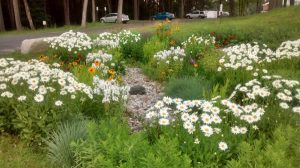
Rain garden at the VA Central Western Massachusetts Health Care System facility.
Photo: US Air Force
With our frequent rainfall, moderately developed urban areas, and expanding communities, the Florida Panhandle is ideal for using green infrastructure to reduce flooding and improve water quality. Features such as bioswales, rain gardens, and permeable pavement can be added to new development to mitigate stormwater runoff; they can also be added to existing neighborhoods to reduce flooding where roadside areas or other shared spaces allow. In addition to mitigating the effects of rainfall, green infrastructure can also improve property values because of their visual appeal. For green infrastructure techniques to be effective, they require widespread use throughout a neighborhood rather than at a handful of locations; so if it sounds like green infrastructure would benefit your community, talk with your neighbors and reach out to UF IFAS agents to discuss how it could be added to your community!
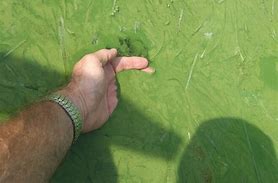
by Rick O'Connor | Aug 17, 2018
Being in the panhandle of Florida you may, or may not, have heard about the water quality issues hindering the southern part of the state. Water discharged from Lake Okeechobee is full of nutrients. These nutrients are coming from agriculture, unmaintained septic tanks, and developed landscaping – among other things. The discharges that head east lead to the Indian River Lagoon and other Intracoastal Waterways. Those heading west, head towards the estuaries of Sarasota Bay and Charlotte Harbor.

A large bloom of blue-green algae (cyanobacteria) in south Florida waters.
Photo: NOAA
Those heading east have created large algal blooms of blue-green algae (cyanobacteria). The blooms are so thick the water has become a slime green color and, in some locations, difficult to wade. Some of developed skin rashes from contacting this water. These algal blooms block needed sunlight for seagrasses, slow water movement, and in the evenings – decrease needed dissolved oxygen. When the algae die, they begin to decompose – thus lower the dissolved oxygen and triggering fish kills. It is a mess – both environmentally and economically.
On the west coast, there are red tides. These naturally occurring events happen most years in southwest Florida. They form offshore and vary in intensity from year to year. Some years beachcombers and fishermen barely notice them, other years it is difficult for people to walk the beaches. This year is one of the worst in recent memories. The increase in intensity is believed to be triggered by the increase in nutrient-filled waters being discharged towards their area.
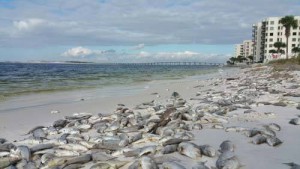
Dead fish line the beaches of Panama City during a red tide event in the past.
Photo: Randy Robinson
On both coasts, the economic impact has been huge and the quality of life for local residents has diminished. Many are pointing the finger at the federal government who, through the Army Corp of Engineers, controls flow in the lake. Others are pointing the finger at shortsighted state government, who have not done enough to provide a reserve to discharge this water, not enforced nutrient loads being discharged by those entities mentioned above. Either way, it is a big problem that has been coming for some time.
As bad as all of this is, how does this impact us here in the Florida panhandle?
Though we are not seeing the impacts central and south Florida are currently experiencing, we are not without our nutrient discharge issues. Most of Florida’s world-class springs are in our part of the state. In recent years, the water within these springs have seen an increase in nutrients. This clouds the water, changing the ecology of these systems and has already affected glass bottom boat tours at some of the classic springs. There has also been a decline in water entering the springs due to excessive withdrawals from neighboring communities. The increase in nutrients are generally from the same sources as those affecting south Florida.
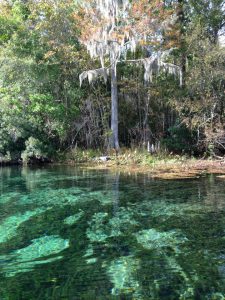
Florida’s springs are world famous. They attracted native Americans and settlers; as well as tourists and locals today.
Photo: Erik Lovestrand
Though we are not seeing large algal blooms in our local estuaries, there are some problems. St. Joe Bay has experienced some algal blooms, and a red tide event, in recent years that has forced the state to shorten the scallop season there – this obviously hurts the local economy. Due to stormwater runoff issues and septic tanks maintenance problems, health advisories are being issued due to high fecal bacteria loads in the water. Some locations in the Pensacola area have levels high enough that advisories must be issued 30% of the time they are sampled – some as often as 40%. Health advisories obviously keep tourists out of those waterways and hurt neighboring businesses as well as lower the quality of life for those living there.
Then of course, there is the Apalachicola River issue. Here, water that normally flows from Georgia into the river, and eventually to the bay, has been held back for water needs in Georgia. This has changed flow and salinity within the bay, which has altered the ecology of the system, and has negatively impacted one of the more successful seafood industries in the state. The entire community of Apalachicola has felt the impact from the decision to hold the water back. Though the impacts may not be as dramatic as those of our cousins in south Florida, we do have our problems.
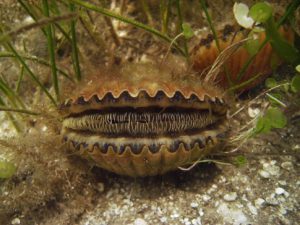
Bay Scallop Argopecten iradians
http://myfwc.com/fishing/saltwater/recreational/bay-scallops/
What can we do about it?
The quick answer is reduce our nutrient input.
The state has adopted Best Management Practices (BMPs) for farmers and ranchers to help them reduce their impact on ground water and surface water contamination from their lands. Many panhandle farmers and ranchers are already implementing these BMPs and others can. We encourage them to participate. Read more at Florida’s Rangeland Agriculture and the Environment: A Natural Partnership – https://nwdistrict.ifas.ufl.edu/nat/2015/07/18/floridas-rangeland-agriculture-and-the-environment-a-natural-partnership/.
As development continues to increase across the state, and in the panhandle, sewage infrastructure is having trouble keeping up. This forces developments to use septic tanks. Many of these septic systems are placed in low-lying areas or in soils where they should not be. Others still are not being maintained property. All of this leads to septic leaks and nutrients entering local waterways. We would encourage local communities to work with new developments to be on municipal sewer lines, and the conversion of septic to sewer in as many existing septic systems as possible. Read more at Maintaining Your Septic Tank – https://nwdistrict.ifas.ufl.edu/nat/2017/04/29/maintain-your-septic-system-to-save-money-and-reduce-water-pollution/.
And then there are the lawns. We all enjoy nice looking lawns. However, many of the landscaping plans include designs that encourage plants that need to be watered and fertilized frequently as well as elevations that encourage runoff from our properties. Following the BMPs of the Florida Friendly Landscaping ProgramTM can help reduce the impact your lawn has on the nutrient loads of neighboring waterways. Read more at Florida Friendly Yards – https://nwdistrict.ifas.ufl.edu/nat/2018/06/08/restoring-the-health-of-pensacola-bay-what-can-you-do-to-help-a-florida-friendly-yard/.
For those who have boats, there is the Clean Boater Program. This program gives advice on how boaters can reduce their impacts on local waterways. Read more at Clean Boater – https://floridadep.gov/fco/cva/content/clean-boater-program.
One last snippet, those who live along the waterways themselves. There is a living shoreline program. The idea is return your shoreline to a more natural state (similar to the concept of Florida Friendly LandscapingTM). Doing so will reduce erosion of your property, enhance local fisheries, as well as reduce the amount of nutrients reaching the waterways from surrounding land. Installing a living shoreline will take some help from your local extension office. The state actually owns the land below the mean high tide line and, thus, you will need permission (a permit) to do so. Like the principals of a Florida Friendly Yard, there are specific plants you should use and they should be planted in a specific zone. Again, your county extension office can help with this. Read more at The Benefits of a Living Shoreline – https://nwdistrict.ifas.ufl.edu/nat/2017/10/06/the-benefits-of-a-living-shoreline/.
Though we may not be experiencing the dramatic problems that our friends in south Florida are currently experiencing, we do have our own problems here in the panhandle – and there is plenty we can do to keep the problems from getting worse. Please consider some of them. You can always contact your local county extension office for more information.
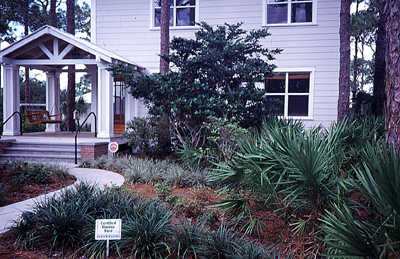
by Rick O'Connor | Jun 8, 2018
We have been posting articles discussing some of the issues our estuaries are facing; this post will focus on one of the things you can do to help reduce the problem – a Florida Friendly Yard.
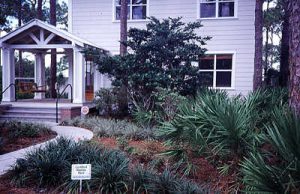
Florida Friendly Landscaping saves money and reduces our impact on the estuarine environment.
Photo: UF IFAS
The University of Florida IFAS developed the Florida Friendly Landscaping Program. It was developed to be included in the Florida Yards & Neighborhoods (FYN) program, HomeOwner and FYN Builder and Developer programs, and the Florida-Friendly Best Management Practices for Protection of Water Resources by the Green Industries (GI-BMP) Program in 2008.
A Florida Friendly Yard is based on nine principals that can both reduce your impact on local water quality but also save you money. Those nine principals are:
- Right Plant, Right Place – We recommend that you use native plants in the right location whenever possible. Native plants require little fertilizer, water, or pesticides to maintain them. This not only reduces the chance of these chemicals entering our waterways but also saves you money. The first step in this process is to have your soil tested at your local extension office. Once your soil chemistry is known, extension agents can do a better job recommending native plants for you.
- Water Efficiently – Many homeowners in the Florida panhandle have irrigation systems on timers. This makes sense from a management point of view but can lead to unnecessary runoff and higher water bills. We have all seen sprinkler systems operating during rain events – watering at that time certainly is not needed. FFY recommends you water only when your plants show signs of wilting, water during the cooler times of day to reduce evaporation of your resource, and check system for leaks periodically. Again, this helps our estuaries and saves you money.
- Fertilize Appropriately – No doubt, plants need fertilizer. Water, sunlight, and carbon dioxide produce the needed energy for plants to grow, but it does not provide all of the nutrients needed to create new cells – fertilizers provide needed those nutrients. However, plants – like all creatures – can only consume so much before the remainder is waste. This is the case with fertilizers. Fertilizer that is not taken up by the plant will wash away and eventually end up in a local waterway where it can contribute to eutrophication, hypoxia, and possible fish kills. Apply fertilizers according to UF/IFAS recommendations. Never fertilize before a heavy rain.
- Mulch – In a natural setting, leaf litter remains on the forest floor. The environment and microbes, recycling needed nutrients within the system, break down these leaves. They also reduce the evaporation of needed moisture in the soil. FFY recommends a 2-3” layer of mulch in your landscape.
- Attract Wildlife – Native plants provide habitat for a variety of local wildlife. Birds, butterflies, and other creatures benefit from a Florida Friendly Yard. Choose plants with fruits and berries to attract birds and pollinators. This not only helps maintain their populations but you will find enjoyment watching them in your yard.
- Manage Yard Pests Responsibly – This is a toughie. Once you have invested in your yard, you do not want insect, or fungal, pests to consume it. There is a program called the Integrated Pest Management Program (IPM) that is recommended to help protect your lawn. The flow of the program basically begins with the least toxic form of pest management and moves down the line. Hopefully, there will not be a need for strong toxic chemicals. Your local county extension office can assist you with implementing an IPM program.
- Recycle – Return valuable nutrients to the soil and reduce waste that can enter our waterways by composting your turfgrass clippings, raked leaves, and pruned plants.
- Reduce Stormwater Runoff – ‘All drains lead to the sea’ – this line from Finding Nemo is, for the most part, true. Any water leaving your property will most likely end in a local waterway, and eventually the estuary. Rain barrels can be connected to rain gutters to collect rainwater. This water can be used for irrigating your landscape. I know of one family who used it to wash their clothes. Rain barrels must be maintained properly to not produce swarms of mosquitos, and your local extension office can provide you tips on how to do this. More costly and labor intensive, but can actually enhance your yard, are rain gardens. Modifying your landscape so that the rainwater flows into low areas where water tolerant plants grow not only reduces runoff but also provides a chance to grow beautiful plants and enhance some local wildlife.
- Protect the Waterfront – For those who live on a waterway, a living shoreline is a great way to reduce your impact on poor water quality. Living shorelines reduce erosion, remove pollutants, and enhance fisheries – all good. A living shoreline is basically restoring your shoreline to a natural vegetative state. You can design this so that you still have water access but at the same time help reduce storm water runoff issues. Planting below the mean high tide line will require a permit from the Florida Department of Environmental Protection, since the state owns that land, and it could require a breakwater just offshore to help protect those plants while they are becoming established. If you have questions about what type of living shoreline you need, and how to navigate the permit process, contact your local county extension office.
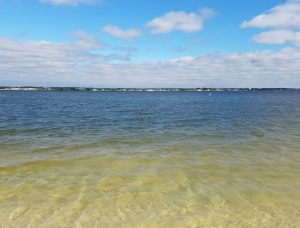
Santa Rosa Sound
Photo: Dr. Matt Deitch
These nine principals of a Florida Friendly Yard, if used, will go a long way in reducing our communities’ impact on the water and soil quality in our local waterways. Read more at http://fyn.ifas.ufl.edu/about.htm.
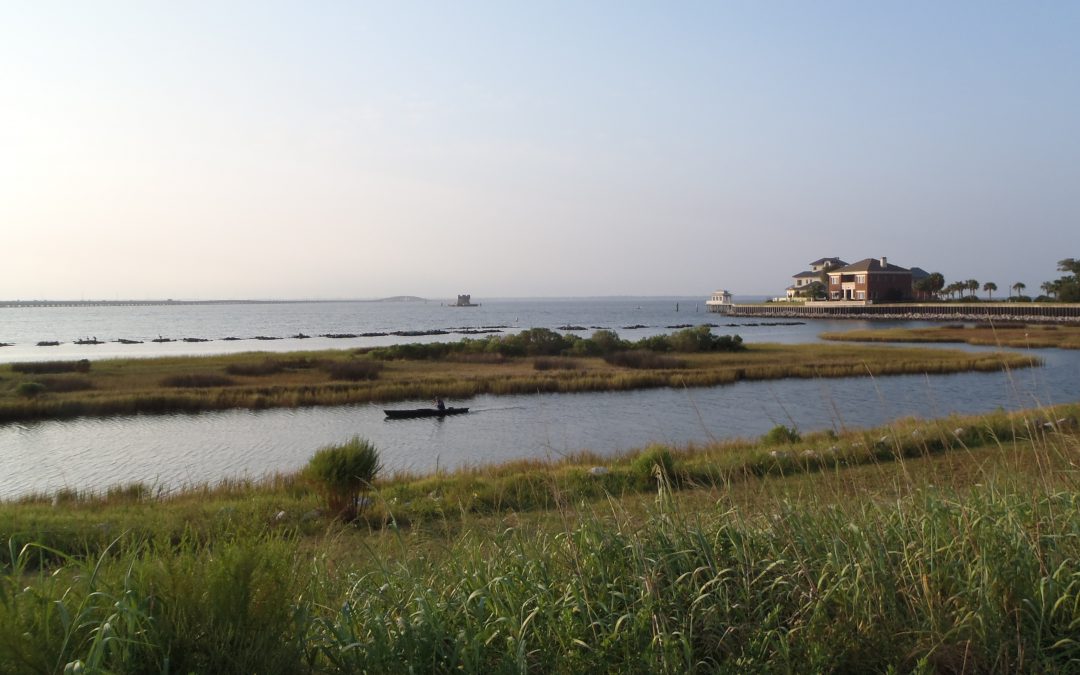
by Rick O'Connor | Oct 6, 2017
Imagine this…
You are a sailor on a 16th century Spanish galleon anchored in a Florida Bay south of Tampa. You, along with others, are ordered to go ashore for a scouting trip to set up a base camp. You transfer over to a small skiff and row ashore to find a forest of root tangled mangroves. There is no dry beach to land so you disembark at the edge of the trees in knee-deep water. The bottom is sandy and your footing is good but you must literally crawl through the tangled mess of mangrove prop roots to finding dry ground. As you do, you encounter spider webs, numerous biting insects, and the bottom becomes muddy and footing is less stable. I am sure I would have returned to the ship to report to the captain that there is nothing of value here – let’s go back to Spain!
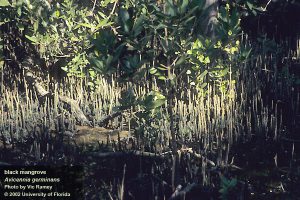
The dense vegetation of a black mangrove swamp in south Florida.
Photo: UF IFAS
Along the shores of northwest Florida it would have been different only that they would have encountered acres of grass instead of trees. The approach to Pensacola would have found a long beach of white sand and dunes. Entering the bay, they would have found salt marshes growing in the protected areas, with the rare exception of dryer bluffs in some spots – which is where de Luna chose to anchor. These marshes are easier to traverse than the emergent root system of the mangrove, but the muck and mire of the muddy bottom and biting insects still remain.
For centuries, Europeans have sought to alter these habitats to make them more suitable for colonization. Whether that was for log forts and houses or marinas and golf courses, we have cleared the vegetation and filled the muck with fill dirt. But have we lost something by doing this?
Yes… Yes we have, and some of what we have lost is valuable to us.
We have lost our water quality.
These emergent shoreline plants filter debris running from shore to the sea during rain events. The muck and mire we encounter within the marsh would otherwise entered the bay or bayou. Here it would cloud the water and smother the submerge seagrasses. My father-in-law told me that as a kid growing up on Bayou Texar in Pensacola he remembered clear water and seagrasses. He remembered throwing a cast net and collecting 4-5″ shrimp.
That has changed.
In our modern world, it is not just mud that is running off towards our bays. We can add lawn fertilizers, lawn and garden pesticides, oils and grease from cleaning, and a multitude of other products – including plastics.
We have seen a decline in living resources.
The large shrimp my father-in-law talked about are not as common. He spoke of snapper – very few now. Bay scallops are basically gone in Pensacola and have declined across much of Florida’s gulf coast. Horseshoe crabs have become rare in many locations. Moreover, salt marsh/mangrove dependent species, such as diamondback terrapins, are difficult to find.
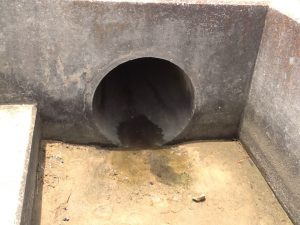
Storm drains, such as this one, discharge run-off into local bays and bayous.
Photo: Rick O’Connor
Maybe of more concern is the decline of commercially important aquatic species such as crabs, shrimp, and finfish. It is known that 80-90% of these commercially important species spend at least part of their lives in the marshes and mangroves.
And this we are losing.
And then there is the shoreline itself.
The emergent plants the Spanish encountered actually act as a wave break. Sand running off the land is trapped to form a “beach”, albeit a mucky one, and the wave energy is absorbed by the plants reducing the energy reaching the shore. The damage in south Florida from hurricane Andrew was devastating. But that same storm made a second landfall in the marshes of Louisiana and there was little to write about – the marsh absorbed much of the energy. The removal of these vegetated shorelines has enhanced the loss of coastline across the Gulf States.
Can we restore these shores and return these “services”?
Yes…
Whether communities want to or not is another question, but we can.
Studies have shown that a marsh 10′ across from water to land can remove 90% of the nutrients running off. Nutrients can trigger hypereutrophic conditions in the bay – which can lead to algal blooms – which can lead to low dissolved oxygen – which can lead to fish kills and seagrass loss. In addition to removing nutrients, marshes and mangroves can remove a variety of other contaminants and plastics. Many sewage treatment facilities discharge their treated effluent through the coastal plant communities before it reaches the bay, thus improving water quality.
We know that restoring a living shoreline will enhance the biological productivity of the bay. Studies have shown that swamps and marshes can produce an annual mean net primary production of between 8000 – 9000 kcal/m2/year, which is equivalent to tropical rainforest and the open estuary itself.
Finally, living shorelines will stabilize erosion issues, much longer than seawalls and other harden structures. Studies have shown that seawalls will eventually give in. Wave energy is increased when it meets the wall and reflects back. This generates higher energy waves that decrease seagrasses and actually begins to remove sediment around the wall itself. You will see the land begin to erode behind the wall and eventually it begins to fall forward into the bay. The east coast of Florida recently experienced this during hurricane Irma. Interestingly the west coast experienced negative tides. The exposure of these seawalls to an empty bay had the same effect. Without the water pressure to hold them, they began to crack and fall forward. A living shoreline can sustain all of this.
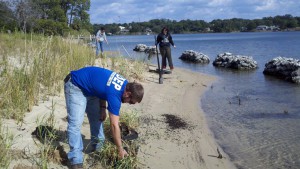
FDEP planting a living shoreline on Bayou Texar in Pensacola.
Photo: FDEP
So how do restore my shoreline?
- You will need a permit. The state of Florida owns land from the mean high tide seaward. To plant above this line you do not need a permit, but you will want to plant at and below to truly restore and benefit from the services. Permitting can be simple or complicated – each property is different. Visit http://escambia.ifas.ufl.edu/permitting-living-shorelines/ to learn more about the process.
- You will need plants. There are a few nurseries that provide the needed species. There is a zonation to the plant community and it is important to put the right plant in the right place. The above link can help with this and the Extension office is happy to visit your location and give recommendations.
- You will need to plant them. Fall and spring are good planting times. A recent project we helped with planted in April and it has been very successful.
- You may want to monitor the success of your project. This not needed, but if interested the Extension office we can show how to do this.I certainly understand why many would rather remove these shoreline ecosystems, but I think you can see the benefits outweigh the problems. It is not an all or none deal. Living shorelines can be designed to allow water access. If interested in learning more contact your county Extension office.
I certainly understand why many would rather remove these shoreline ecosystems, but I think you can see the benefits outweigh the problems. It is not an all or none deal. Living shorelines can be designed to allow water access. If interested in learning more contact your county Extension office.
References
Permitting a Living Shoreline; can a living shoreline work for you? http://escambia.ifas.ufl.edu/permitting-living-shorelines/.
Miller Jr., G.T., S.E. Spoolman. 2011. Living in the Environment: Concepts, Connections, and Solutions. 16th edition. Brooks and Cole Cengage Learning. Pp. 674.
Sharma, S. J. Goff, J. Cebrian, C. Ferraro. 2016. A Hybrid Shoreline Stabilization Technique: Impact of Modified Intertidal Reefs on Marsh Expansion and Nekton Habitat in the Northern Gulf of Mexico. Ecological Engineering 90. Pp 352-360.
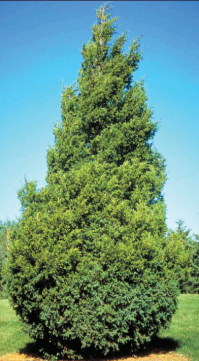
by Carrie Stevenson | Jan 8, 2017
Arbor Day has a 145-year history, started in Nebraska by a nature-loving newspaper editor who recognized the many valuable services trees provide. We humans often form emotional attachments to trees, planting them at the beginning of a marriage, birth of a child, or death of a loved one, and trees have tremendous symbolic value within cultures and religions worldwide. So it only makes sense that trees have their own holiday. The first Arbor Day was such a big success that his idea quickly spread nationwide–particularly with children planting trees on school grounds. In addition to their aesthetic beauty and valuable shade in the hot summers, trees provide countless benefits: wood and paper products, nut and fruit production, wildlife habitat, stormwater uptake, soil stabilization, carbon dioxide intake, and oxygen production. If you’re curious of the actual dollar value of a tree, the handy online calculator at TreeBenefits.com can give you an approximate lifetime value of a tree in your own backyard.
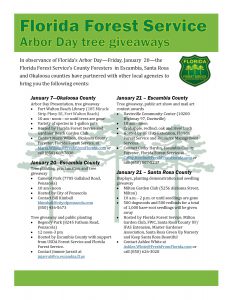
Arbor Day events in the western Panhandle.
While national Arbor Day is held the last Friday in April, Arbor Day in Florida is always the third Friday of January. Due to our geographical location further south than most of the country, our primary planting season is during our relatively mild winters. Trees have the opportunity during cooler months to establish roots without the high demands of the warm growing season in spring and summer.
To commemorate Arbor Day, many local communities will host tree giveaways,plantings, and public ceremonies. In the western Panhandle, the Florida Forest Service, UF/IFAS Extension, and local municipalities have partnered for several events, listed here.
For more information on local Arbor Day events and tree giveaways in your area, contact your local Extension Office or County Forester!





















